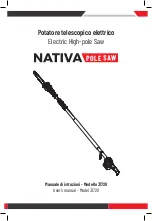
ASSEMBLY
19
UNPACKING
This product has been shipped completely assembled.
• Carefully lift the saw from the carton and place it on a
level work surface.
• Inspect the tool carefully to make sure no breakage or
damage occurred during shipping.
• Do not discard the packing material until you have
carefully inspected and satisfactorily operated the tool.
• The saw is factory set for accurate cutting. After
assembling it, check for accuracy. If shipping has
influenced the settings, refer to specific procedures
explained in this manual.
• If any parts are damaged or missing, please call
1-866-206-0888 for assistance.
• Do not assemble the machine if parts are missing.
• Do not connect the machine to the power source until
you have read and understood the entire operation
manual.
• Do not attempt to modify this tool or create accessories
not recommended for use with this tool. Any such
alteration or modification is misuse and could result in a
hazardous condition leading to possible serious
personal injury.
• Use the parts list in page 30 of this manual to order
replacement parts.
MOUNTING THE SCROLL SAW TO A
WORKBENCH
Always securely mount scroll saw to a workbench to avoid
serious personal injury from unexpected tool movement.
If the scroll saw is to be used in a permanent application,
we recommend that you secure it in a permanent loca-
tion such as a workbench. When mounting the saw to a
workbench, holes should be drilled through the supporting
surface of the workbench.
Each hole in the base of the saw should be bolted secure-
ly using machine bolts, washers, and nuts (not included).
Bolts should be of sufficient length to accommodate the
saw base, washers, nuts, and the thickness of the work-
bench.
Place scroll saw on workbench. Using the saw base as a
pattern, locate and mark the holes where the scroll saw is
to be mounted.
• Drill three holes through the workbench.
• Place scroll saw on workbench aligning holes in the saw
base with the holes drilled in the workbench.
• Insert all three bolts (not included) and tighten securely
with washers and nuts (not included).
NOTE:
All bolts should be inserted from the top. Install the
washers and nuts from the underside of the bench.
The supporting surface where the scroll saw is mounted
should be examined carefully after mounting to insure
that no movement during use can result. If any tipping or
walking is noted, secure workbench or supporting surface
before beginning cutting operations.
Figure 1
To Reduce Noise and Vibration:
You may wish to place a foam pad or piece of carpet
between the saw base and the workbench to help reduce
noise and vibration. If a foam pad or piece of carpet is
used, do not over tighten the mounting bolts. Leave some
cushion between the padding and the saw base to help
absorb the noise and vibration.
The size of the padding material should be approximately
24 in. x 12 in. x 1/2 in.
CLAMPING SCROLL SAW TO WORKBENCH
If the scroll saw is to be used in a portable application, it is
recommended that you fasten it permanently to a mount-
ing board that can easily be clamped to a workbench or
other supporting surface. The mounting board should be
of sufficient size to avoid tipping of saw while in use. Any
good grade plywood or chipboard with a 3/4 in. thickness
is recommended.
• Mount saw to board using holes in saw base as a
template for hole pattern. Locate and mark the holes
where scroll saw is to be mounted.
• Follow the last three steps in previous section called
mounting scroll saw.
If lag bolts are being used, make sure they are long
enough to go through holes in the saw base and the mate-
rial to which the saw is being mounted.
If machine bolts are being used, make sure they are long
enough to go through holes in the saw base, the material
the saw is being mounted to, and the washers and nuts.
NOTE:
It may be necessary to counter sink washers and
nuts on the bottom side of mounting board.
WARNING
Mounting Surface
WARNING













































